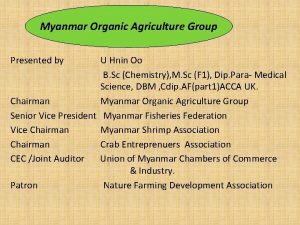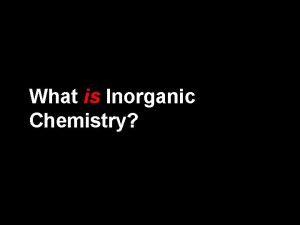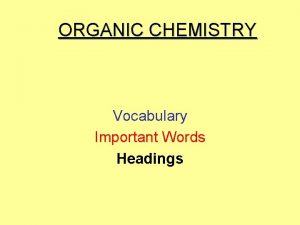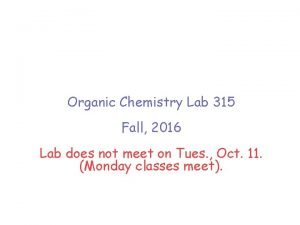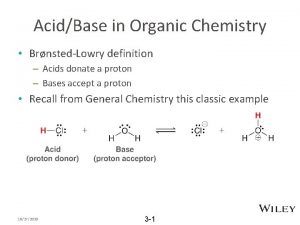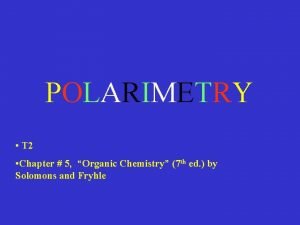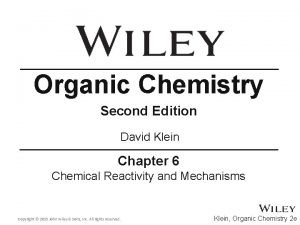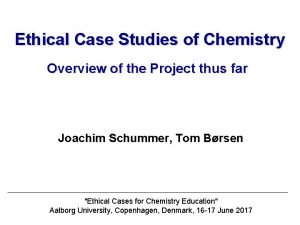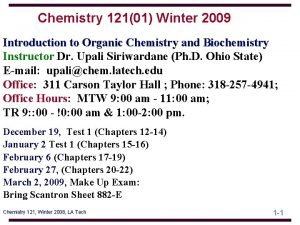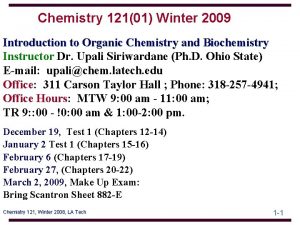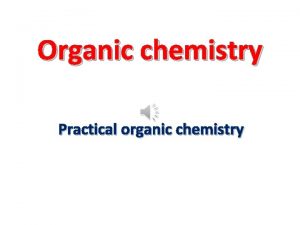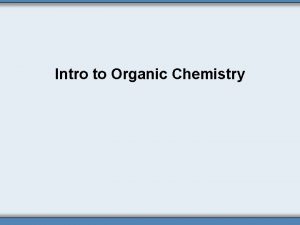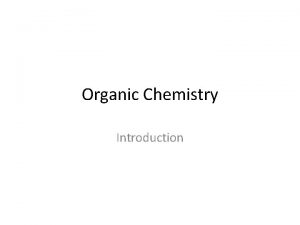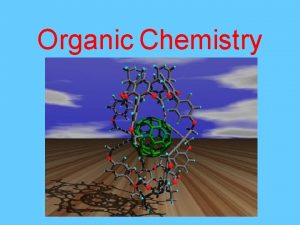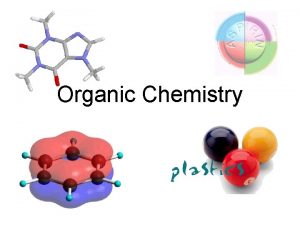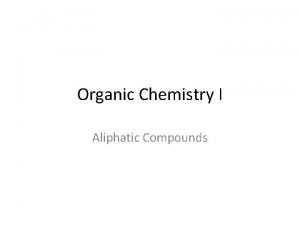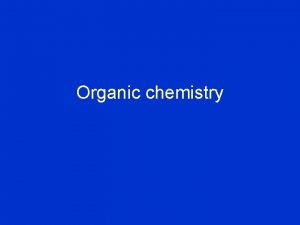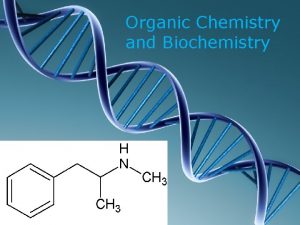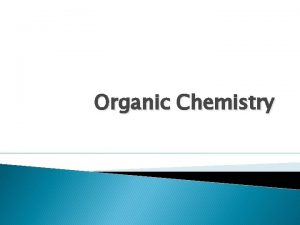Chemistry 12101 Winter 2009 Introduction to Organic Chemistry






















































- Slides: 54

Chemistry 121(01) Winter 2009 Introduction to Organic Chemistry and Biochemistry Instructor Dr. Upali Siriwardane (Ph. D. Ohio State) E-mail: upali@chem. latech. edu Office: 311 Carson Taylor Hall ; Phone: 318 -257 -4941; Office Hours: MTW 9: 00 am - 11: 00 am; TR 9: : 00 - !0: 00 am & 1: 00 -2: 00 pm. December 19, Test 1 (Chapters 12 -14) January 2 Test 1 (Chapters 15 -16) February 6 (Chapters 17 -19) February 27, (Chapters 20 -22) March 2, 2009, Make Up Exam: Bring Scantron Sheet 882 -E Chemistry 121, Winter 2008, LA Tech 1 -1

Chapter 12. Saturated Hydrocarbons Sections 12. 4 -12. 14 & 12. 6 Chemistry 121, Winter 2008, LA Tech 1 -2

Chapter 12. Saturated Hydrocarbons 12. 4 12. 6 12. 7 12. 8 12. 10 12. 11 12. 12 12. 13 12. 14 12. 15 12. 16 12. 17 12. 18 Alkanes: Acyclic Saturated Hydrocarbons Alkane Isomerism Conformations of Alkanes IUPAC Nomenclature for Alkanes Classification of Carbon Atoms Branched-Chain Alkyl Groups Cycloalkanes IUPAC Nomenclature for Cycloalkanes Isomerism in Cycloalkanes Sources of Alkanes and Cycloalkanes Physical Properties of Alkanes and Cycloalkanes Chemical Properties of Alkanes and Cycloalkanes Nomenclature and Properties of Halogenated Alkanes Chemical Connections: Chlorofluorocarbons and the Ozone Layer Chemistry 121, Winter 2008, LA Tech 1 -3

Types of formula for organic compounds Chemical formula: Indicate the kind and number of each type of atom in the molecule. Condensed formula: Shows skeletal atoms in a molecule and places them in a sequential order that indicates bonding. Structural formula: Shows each atom and bonds in a molecule. Line-angle formula: The hydrogen atoms are removed from carbon chains, leaving just a carbon line skeleton with functional groups attached to it. Chemistry 121, Winter 2008, LA Tech 1 -4

Alicyclic Alkanes Are saturated hydrocarbons: • Noncyclic alkanes: General molecular formula, Cn. H 2 n+2 Structural formula: Chemistry 121, Winter 2008, LA Tech 1 -5

Organic Nomenclature Organic molecules can be very complex. Naming system must be able to tell • • • Number of carbons in the longest chain The location of any branches Which functional groups are present and where they are located. The IUPAC Nomenclature System provides a uniform set of rules that we can follow. Chemistry 121, Winter 2008, LA Tech 1 -6

Naming alkanes 1 Find the longest carbon chain. Use as base name with an ane ending. 2 Locate any branches on chain. Use base names with a yl ending. 3 For multiple branch of the same type, modify name with di, tri, . . . 4 Show the location of each branch with numbers. 5 List multiple branches alphabetically - the di, tri, . . . don’t count. . Chemistry 121, Winter 2008, LA Tech 1 -7

Alkanes First four members of the alkanes Name # of C Condensed formula Methane 1 CH 4 Ethane 2 CH 3 Propane 3 CH 3 CH 2 CH 3 Butane 4 CH 3 CH 2 CH 3 Called a homologous series • “Members differ by number of CH 2 groups” Chemistry 121, Winter 2008, LA Tech 1 -8

Nomenclature: Unbranched or straight chain alkanes General molecular formula: Cn. H 2 n+2 All bond angles about tetrahedral carbon are approximately 109. 5° Chemistry 121, Winter 2008, LA Tech 1 -9

Isomerism Isomers - different compounds having the same molecular formula but different structural formulas There are two type of Isomers: Constitutional isomerism: Different connections among atoms in the • Skeleton • Position • Functional group Stereoisomerism: Same connectivity among atoms, but these atoms differ in spatial orientation • geometric • conformational • optical Chemistry 121, Winter 2008, LA Tech 1 -10

Constitutional Isomers Skeletal (Chp. 12) Positional (Chp. 12) Functional (Chp. 14) Stereoisomers Geometric (Chp. 13) Conformational (Chp. 12) Enantiomers (Optical) (Chp. 16) Chemistry 121, Winter 2008, LA Tech 1 -11

Constitutional isomers in butane Constitutional isomers: compounds with the same molecular formula but a different connectivity of their atoms in the skeleton. There are two constitutional isomers with molecular formula C 4 H 10 Chemistry 121, Winter 2008, LA Tech 1 -12

Constitutional isomers Compounds with the same number and type of atoms but with different arrangements. Molecular Formula C 5 H 12 Condensed structural formulas. CH 3 CH 2 CH 2 CH 3 CH(CH 3)CH 2 CH 3 (CH 3)4 C pentane 2 -methylbutane 2, 2 -dimethylpropane All are constitutional isomers of C 5 H 12. Chemistry 121, Winter 2008, LA Tech 1 -13

Rules of IUPAC Nomenclature of Branched Alkanes Parent name: the longest carbon chain Substituent: a group bonded to the parent chain Alkyl group: a substituent derived by removal of a hydrogen from an alkane; given the symbol Rwritten in alphabetical order CH 4 becomes CH 3 - (methyl) CH 3 becomes CH 3 CH 2 - (ethyl) Prefixes: di-, tri-, tetra-, etc. are not included in alphabetization Chemistry 121, Winter 2008, LA Tech 1 -14

Common alkyl groups Chemistry 121, Winter 2008, LA Tech 1 -15

Names of Alkyl Groups methyl propyl isopropyl butyl sec-butyl isobutyl tert-butyl Chemistry 121, Winter 2008, LA Tech H 4 methane: CH 3 - methyl CH 3 ethane: CH 3 CH 2 - ethyl CH 3 CH 2(CH 3)2 CHCH 3 CH 2 CH 2 CH 3 CH 2 (CH 3) CH(CH 3)2 CHCH 2(CH 3)3 C 1 -16

IUPAC Nomenclature of branched alkanes • suffix -ane specifies an alkane • prefix tells the number of carbon atoms Chemistry 121, Winter 2008, LA Tech 1 -17

Example Name the following. (CH 3)2 CHCH 2 CH(CH 3)2 This is a condensed structural formula. First convert it to a carbon skeleton, leaving out the hydrogen. Chemistry 121, Winter 2008, LA Tech 1 -18

(CH 3)2 CHCH 2 CH(CH 3)2 C C | | C-C-C-C Now name it! Chemistry 121, Winter 2008, LA Tech 1 -19

C C | | C-C-C-C 1. Longest chain is 6 - hexane 2. Two methyl groups - dimethyl 3. Use 2, 5 -dimethylhexane Chemistry 121, Winter 2008, LA Tech 1 -20

Giving IUPAC names • CH 3 CH 2 CH(CH 3)CH 2 CH 2 CH 3 Parent name: octane Substituent: Methyl at 4 4 -mehtyl Name: 4 -Methyloctane CH 3 C(CH 3)2 CH 2 CH(CH 2 CH 3)CH 2 CH 3 Chemistry 121, Winter 2008, LA Tech 1 -21

Types of carbon and hydrogen atoms Primary (1°) carbon: a C bonded to one other carbon Secondary (2°) carbon : a C bonded to two other carbons Tertiary (3°) carbon : a C bonded to three other carbons Quaternary (4°) carbon : a C bonded to four other carbons Primary (1°) hydrogen: Secondary (2°) hydrogen : Tertiary (3°) hydrogen : Chemistry 121, Winter 2008, LA Tech a H bonded to primary (1°) carbon a H bonded to secondary (2°) carbon a H bonded to tertiary (3°) carbon 1 -22

Conformational Isomerism A type of stereoisomerism in which the isomers (known as conformers) differ by the degree of rotation around a carbon-carbon single bond Newman projections: projections A way used to represent conformers using a projection that looks down a carbon-carbon bond front carbon back carbon Newman Projection Chemistry 121, Winter 2008, LA Tech 1 -23

Staggered and Eclipsed conformations of alkanes and cycloalkanes Conformation Stereoisomerism: Any three-dimensional arrangement of atoms in a molecule that results from rotation about a single bond Staggered conformation: A conformation about a carbon single bond where the atoms on one carbon are as far apart as possible from the atoms on an adjacent carbon Chemistry 121, Winter 2008, LA Tech Newman Projection 1 -24

Conformations of Alkanes Conformers shown by Newman Projections Ethane : staggered, ecliped Butane: two staggered and two ecliped conformations Chemistry 121, Winter 2008, LA Tech 1 -25

Eclipsed conformation: a conformation about a carbon -carbon single bond in which the atoms on one carbon are as close as possible to the atoms on an Newman adjacent carbon Projection Lowest energy conformation of an alkane is a fully staggered conformation. The torsional strain between staggered and eclipsed ethane is approximately 3. 0 kcal (12. 6 k. J)/ mol Chemistry 121, Winter 2008, LA Tech 1 -26

Sources of Alkanes Natural gas 90 -95% methane, 5 -10% ethane Petroleum • • • gases (bp below 20°C) naphthas, including gasoline (bp 20 - 200°C) kerosene (bp 175 - 275°C) fuel oil (bp 250 - 400°C) lubricating oils (bp above 350°C) asphalt (residue after distillation) Coal Chemistry 121, Winter 2008, LA Tech 1 -27

Molecular Structure and Physical Properties • Bp decreases with hydrocarbon chain branching due to decrease in surface area which results in fewer intermolecular attractions. • Mp increases with hydrocarbon chain branching because the more compact molecules have a better fit in the crystal lattice making it more stable. • Solubility - the quantity of solute that will dissolve in a solvent depends on polarity of solute and solvent. “Like dissolves like” refers to polar liquids tending to dissolve polar solutes and nonpolar liquids tend to dissolve nonpolar solutes. Alkanes are nonpolar. Chemistry 121, Winter 2008, LA Tech 1 -28

Alkanes Physical Properties • Nonpolar molecules • Not soluble in water • Low density • Low melting point These go up as the number of carbons increases. • Low boiling point Chemistry 121, Winter 2008, LA Tech 1 -29

Physical Properties of Alkanes Name bp, o. C Methane -161. 7 Ethane - 88. 6 Propane - 42. 2 Butane -0. 5 Pentane 36. 1 Hexane 68. 7 Heptane 98. 4 Octane 125. 6 Nonane 150. 7 Decane 174. 0 Chemistry 121, Winter 2008, LA Tech mp, o. C -182. 6 -182. 8 -187. 1 -135. 0 -129. 7 - 94. 0 - 90. 5 - 56. 8 -53. 7 -29. 7 Density at 20 o. C 0. 000667 0. 00125 0. 00183 0. 00242 0. 626 0. 659 0. 684 0. 703 0. 718 0. 730 1 -30

Physical Properties of The Saturated Hydrocarbons Name Molecular Formula Melting Point (o. C) Boiling Point (o. C) State at 25 o. C methane CH 4 -182. 5 -164 gas ethane C 2 H 6 -183. 3 -88. 6 gas propane C 3 H 8 -189. 7 -42. 1 gas butane C 4 H 10 -138. 4 -0. 5 gas pentane C 5 H 12 -129. 7 36. 1 liquid hexane C 6 H 14 -95 68. 9 liquid heptane C 7 H 16 -90. 6 98. 4 liquid octane C 8 H 18 -56. 8 124. 7 liquid nonane C 9 H 20 -51 150. 8 liquid decane C 10 H 22 -29. 7 174. 1 liquid eicosane C 20 H 42 36. 8 343 solid Chemistry 121, Winter 2008, LA Tech 1 -31

Constitutional isomerism in alkane The number of constitutional isomerism increases with the carbon number in the alkane Chemistry 121, Winter 2008, LA Tech 1 -32

Physical Properties Constitutional isomers are different compounds and have different physical properties Chemistry 121, Winter 2008, LA Tech 1 -33

Reactions of alkanes Halogenation • A reaction where a halogen replaces one or more hydrogens. heat or light CH Cl(g) + HCl(g) CH 4(g) + Cl 2(g) 3 Used to prepare many solvents • • • dichloromethane - paint stripper chloroform - once used as anesthesia 1, 2 -dichloroethane - dry cleaning fluid Chemistry 121, Winter 2008, LA Tech 1 -34

Reactions of alkanes Combustion • CH 4(g) + 2 O 2(g) CO 2(g) + 2 H 2 O(g) Many alkanes are used this way - as fuels • • Methane Propane Butane Gasoline Chemistry 121, Winter 2008, LA Tech - natural gas used in gas grills lighters mixture of many hydrocarbons, 1 -35

Reactions of Alkanes Oxidation is the basis for the use of alkanes as energy sources for heat and power heat of combustion: heat released when one mole of a substance is oxidized to carbon dioxide and water in a combustion reaction. Chemistry 121, Winter 2008, LA Tech 1 -36

Synthesis Gas A mixture of carbon monoxide and hydrogen in varying proportions, depending on how it is produced Methanol and acetic acid are produced from synthesis gas Chemistry 121, Winter 2008, LA Tech 1 -37

Cycloalknes Cyclic alkanes: General molecular formula, Cn. H 2 n Structure and nomenclature • named similar to noncyclic alkanes • to name, prefix the name of the corresponding open-chain alkane with cyclo-, and name each substituent on the ring • if only one substituent, no need to give it a number • if two substituents, number from the substituent of lower alphabetical order • if three or more substituents, number to give them the lowest set of numbers, and then list substituents in alphabetical order • in planar cyclopentane, all C-C-C bond angles are 108°, which differ only slightly from the tetrahedral angle of 109. 5°consequently there is little angle strain Chemistry 121, Winter 2008, LA Tech 1 -38

Naming simple of cycloalkanes: cyclopropane cyclobutane cyclopentane cyclohexane cycloheptane cyclooctane Chemistry 121, Winter 2008, LA Tech 1 -39

Ring strain in cycloalkane The stability of cycloalkanes depends on their ability to relieve ring strain when the bond angles are less than 109. 5˚. Least stable Chemistry 121, Winter 2008, LA Tech Most stable 1 -40

Naming branched cycloalkanes Commonly written as line-angle formulas examples: Chemistry 121, Winter 2008, LA Tech 1 -41

Cycloalkanes : saturated hydrocarbons with a carbon ring Have C-C single bonds in a ring structure. General formula Cn. H 2 n cyclopropane Chemistry 121, Winter 2008, LA Tech cyclobutane 1 -42

Naming Cycloalkanes Have the carbons connected in a ring. These compounds are known collectively as To name a cycloalkane, use the prefix cyclo- with the parent. If there is only one substituent, a number is not needed. Chemistry 121, Winter 2008, LA Tech 1 -43

Conformations of Cycloalkanes Cyclohexane Chair conformation-low energy Boat conformation-higher energy Chemistry 121, Winter 2008, LA Tech 1 -44

Geometrical (cis & trans) Isomers of Cycloalkanes Carbon ring create a rigid structure trans and cis is used to describe the arrangements of alkyl groups with respect to the plane of the ring cis: on the same side trans: on the opposite sides Chemistry 121, Winter 2008, LA Tech 1 -45

Cis and trans Geometrical isomers of Cycloalkanes two groups are said to be located cis to each other if they lie on the same side of a plane. If they are on opposite sides, their relative position is described as trans. Chemistry 121, Winter 2008, LA Tech 1 -46

Conformations of cyclopentane • In planar cyclopentane, there are 10 fully eclipsed C-H bonds, which create torsional strain of approximately 10 kcal/mol • Puckering to an “envelope” conformation relieves part of this strain • In an envelope conformation, eclipsed interactions are reduced but angle strain is increased slightly (105°) Planar conformation Chemistry 121, Winter 2008, LA Tech Envelope conformation 1 -47

Cyclohexane Conformations: chair most stable Chemistry 121, Winter 2008, LA Tech boat unstable Why? chair most stable 1 -48

Chair conformations of cyclohexane • The most stable conformation is a puckered chair conformation • In a chair conformation, all bond angles are approx. 109. 5°, and all bonds on adjacent carbons are staggered Chemistry 121, Winter 2008, LA Tech Chair conformation 1 -49

Boat conformations of cyclohexane A puckered conformation in which carbons 1 and 4 are bent toward each other • a boat conformation is less stable than a chair conformation by 6. 5 kcal (27 k. J)/mol • torsional strain is created by four sets of eclipsed hydrogen interactions • steric strain (nonbonded interaction strain) is created by one set of flagpole interactions Chemistry 121, Winter 2008, LA Tech 1 -50

Interconversions of conformations Interconvert ion to alternative chair conformations (lower energy) via a boat conformation (higher energy Chemistry 121, Winter 2008, LA Tech 1 -51

Cis and Trans Geometric Isomerism in Cycloalkanes Geometric isomerism: A stereoisomer concerning the orientation differences of atoms or groups around a double bond or ring cis isomer - a geometric isomer where groups are on the same side of a ring or double bond trans isomer - a geometric isomer where groups are on opposite sides of a ring or double bond Chemistry 121, Winter 2008, LA Tech 1 -52

cis-1, 2 -dimethylcyclopentane trans-1, 2 -dimethylcyclopentane cis-1, 4 -dimethylcyclohexane, Chemistry 121, Winter 2008, LA Tech Perspective drawing 1 -53

Problem: draw the alternative chair conformations of this trisubstituted cyclohexane and state which is the more stable Chemistry 121, Winter 2008, LA Tech 1 -54
 Ib organic chemistry
Ib organic chemistry Organic vs inorganic chemistry
Organic vs inorganic chemistry Organic vs inorganic compounds
Organic vs inorganic compounds Winter kommt winter kommt flocken fallen nieder
Winter kommt winter kommt flocken fallen nieder Heute mittwoch guten morgen mittwoch winter
Heute mittwoch guten morgen mittwoch winter Es war eine mutter
Es war eine mutter January 2009 chemistry regents answers
January 2009 chemistry regents answers Father of organic chemistry
Father of organic chemistry Soap organic chemistry
Soap organic chemistry Ester organic chemistry
Ester organic chemistry Structure of pentanoic acid
Structure of pentanoic acid Organic chemistry david klein 3rd edition
Organic chemistry david klein 3rd edition Ee organic chemistry
Ee organic chemistry Ario organic chemistry
Ario organic chemistry Pericyclic
Pericyclic Organic chemistry david klein 3rd edition
Organic chemistry david klein 3rd edition Organic chemistry 2nd edition klein
Organic chemistry 2nd edition klein Leveling effect organic chemistry
Leveling effect organic chemistry What functional group is ch3
What functional group is ch3 Organic chemistry lab report sample
Organic chemistry lab report sample Britannica.com
Britannica.com Organic chemistry grade 10
Organic chemistry grade 10 Organic chemistry
Organic chemistry Organic chemistry wade
Organic chemistry wade Meth eth prop bute
Meth eth prop bute Cracking organic chemistry
Cracking organic chemistry Met et prop but pent hex hept oct non dec undec
Met et prop but pent hex hept oct non dec undec Organic chemistry myanmar
Organic chemistry myanmar Propagation organic chemistry
Propagation organic chemistry M+2 mass spec
M+2 mass spec Hono organic chemistry
Hono organic chemistry Propyl bromide
Propyl bromide Organic chemistry topic 11
Organic chemistry topic 11 Chapter 22 review organic chemistry section 1 answers
Chapter 22 review organic chemistry section 1 answers Organic chemistry reaction pathways
Organic chemistry reaction pathways Organic chemistry nomenclature
Organic chemistry nomenclature What is organic chemistry like
What is organic chemistry like Neon organic or inorganic
Neon organic or inorganic Organic chemistry vocabulary
Organic chemistry vocabulary Organic chemistry david klein 3rd edition
Organic chemistry david klein 3rd edition Organic chemistry laboratory ch 2540 manual
Organic chemistry laboratory ch 2540 manual A level chemistry ocr organic synthesis
A level chemistry ocr organic synthesis Difference between fats and oil
Difference between fats and oil Leveling effect organic chemistry
Leveling effect organic chemistry How to calculate percentage yield in organic chemistry
How to calculate percentage yield in organic chemistry Polarimetry organic chemistry
Polarimetry organic chemistry Organic chemistry third edition david klein
Organic chemistry third edition david klein Radicals
Radicals Hammonds postulate
Hammonds postulate Klein
Klein Organic chemistry chapter 9
Organic chemistry chapter 9 Chemistry-ethics case studies
Chemistry-ethics case studies What functional group is ch3
What functional group is ch3 This name
This name Analytical chemistry chapter 1
Analytical chemistry chapter 1



























